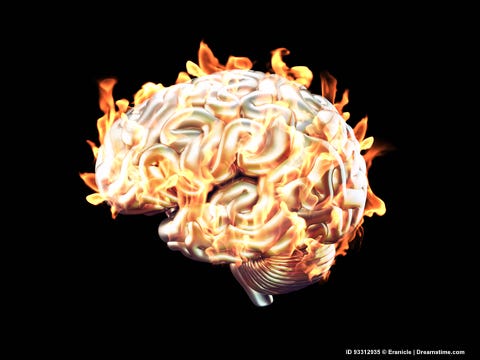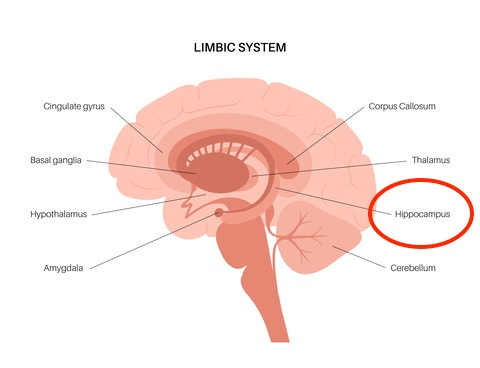Neuroinflammation has been studied for decades. In fact, neuroinflammation was discovered some 30 years ago and first described as systemic infection or CNS injury. It is now described by the listing the proinflammatory mediators within the central nervous system.
The reason neuroinflammation has recently emerged as a dominant theme is due to its association with neurodegenerative states such as Alzheimer’s disease, Parkinson’s disease, and Huntington’s disease. These conditions are often associated with “getting older” because it takes a long time for the inflamed brain to turn into a diseased brain.
It has also been associated with chronic fatigue syndrome (CFS), Gulf War Illness (GWI), and what is referred to as “chemobrain,” cognitive impairment following chemotherapy. An estimated 25% of patients who have undergone chemotherapy experience cognitive deficits that may persist for many years. Symptoms of brain inflammation include lethargy, attention deficits, and sleep disruption. Typically, the neuroinflammation resolves over time, for example, after an infection resolves or after the chemo stops; however, when inflammation continues indefinitely, the result is neurodegeneration.
I first talked about the ability of the spike protein to cross the blood-brain barrier (BBB) in my 40 Mechanisms of Injury Course, released in July 2021. Deep inside this document, published in December 2020, right after the Pfizer jab was released, researchers found that the SARS-CoV-2 spike protein significantly affected the integrity of the BBB, leading to a pro-inflammatory response and BBB dysfunction. By 2022, more and more publications were exposing the effects the spike protein has on the brain, inducing cognitive deficits (memory loss) and anxiety. Attention began to be focused on the effect spike proteins have on the part of the brain known as the hippocampus.
In one study, investigators injected the S1 spike proteins directly into the dorsal hippocampus of the brain of mice, the region critical for cognition, emotion, and memory, and then subjected the mice to a series of behavioral tests. The results showed thinking deficits and anxiety did indeed appear in the mice. They also confirmed by tissue staining that the spike proteins induced cell death, leading to a reduction in the size of the hippocampus by 20-35%.
What is the hippocampus?
The hippocampus has been extensively studied. It is a complex structure embedded deep into the temporal lobe of the brain, playing a major role in learning and memory. It can become damaged by a variety of insults leading to neurological and psychiatric disorders. It is the earliest and most severely affected structure in Alzheimer's disease. The hippocampus also plays an important role in balance, spatial navigation (movement in space), and regulation of hormonal functions controlled by the hypothalamus.
The exact mechanism is not fully understood but atrophy of the hippocampus can be due to a combination of cell loss and suppression of neurogenesis, the formation of new neurons. In an adult animal brain, neurogenesis occurs in the subventricular zone (not discussed here) and the hippocampus.
One of the ways that the hippocampus can be adversely affected is by both acute and chronic stress. Some researchers have suggested that corticosteroids, released during times of heightened distress, might play a role in reducing hippocampal neurogenesis. If the stress continues uncontrolled for an extended period of time, it adversely influences the hippocampus at various levels. As the severity of stress increases (intensity and duration), the activities of neurons, the structure of brain cells, and even the brain's chemical composition change. And neurogenesis within the hippocampus changes profoundly, adversely affecting learning and memory, and eventually leading to abnormal behaviors and neurodegenerative disease.
One of the earliest scientific accounts of the relationship between stress, learning, and psychopathology originated in a paper published in 1927. The research reported that animals under chronic stress showed signs of loss of memory, demonstrated by an inability to perform activities they had previously learned. He called this condition “experimental neurosis.”
In his new book, The Indoctrinated Brain, Dr. Michael Nehl describes in great detail how constant exposure to fear-based messages leads to a strong neurotoxic effect in the brain. In a recent interview with Tucker Carlson, Dr. Nehl described how the spike protein, when it enters the brain, stimulates the production of an entire cascade of pro-inflammatory cytokines that interfere with the hippocampus and shut down our ability to think. And, in his words, “And it gets worse.”
“The daily fear-mongering messages (during COVID-19) shut down and overrode any previous memory of ‘normal’ that we had. They have physically damaged our brains and, by installing new messages, have changed our personalities. ....The evil that this book reveals is traumatic.”
Tucker asked the question, “What does this do to religious persons?”
Dr Nehls’ answer was essentially that your memory of God and your religious practices may be overridden, and you may not have the ability to remember much – if anything – about your faith.
If you missed the interview, you can watch it in full here. It really is worth 45 minutes of your time
What can be done?
He mentioned several supplements that will increase the production of new hippocampal cells and decrease brain inflammation. First and foremost is adequate Vitamin D and secondly, large amounts of omega-3 fatty acids. He also recommends low-dose lithium to regenerate the hippocampus, reduce brain fog, and slow or reduce brain inflammation.
I’ve used Lithium orotate in my office for years for mild to moderate depression and sometimes for chronic migraines. After Dr. Nehl mentioned it, I did a little research and found dozens of studies supporting the use of low-dose lithium for many cognitive disorders, including depression, bipolar disorder, and schizophrenia. Low dose is defined as 10 mg 1-3 times per day of the supplement lithium orotate.
This is very different from the prescription drug Lithium carbonate, usually prescribed as 900 to 1200 mg/day or more, and carries a BOXED WARNING about toxicity.
Boxed warnings (formerly known as Black Box Warnings) are the highest safety-related warning that medications can be assigned by the FDA. These warnings are intended to bring the consumer’s attention to the major risks of the drug. Medications can have a boxed warning added, taken away, or updated throughout their tenure on the market. Over 400 different medications currently have boxed warnings. Here is a partial list.
Nihl says there is much more information in his book. I just arrived on Monday and I’m looking forward to reading it
.









Vitamin D to the rescue...again!
Dr. T Are you sure on the lithium dosage (10mg 3xday)? I watched Nehl’s on Dr. Drew recently and I remember him saying 1mg a day. Clarification much appreciated 😊